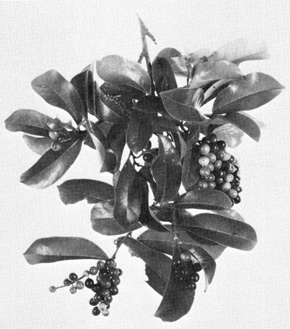|
References: Fouqué 1974, Popenoe 1939, Ruehle et al. 1958. Diospyros kaki L. Common names: Japanese persimmon (English); kaki (Japanese). Origin: China, Japan. Distribution: Worldwide in warm temperate and sub-tropical areas and in tropical highlands. Cultural requirements: Requires seasonal cool period for successful flowering and fruiting, well-distrib-uted rainfall. Description: Tree to 12 m (usually smaller). Propaga-tion by seed, grafting. Flowers March-April (Flor-ida). Dioecious or polygamous. Fruit matures in about 200 days. Fruit ovoid to oblate, 2.5-8 cm in diameter, solitary; external color yellow or orange, internal orange. Utilization: Pulp eaten fresh, dried, preserved. Flavor sweet, pleasant; wide appeal. Good source of vita-min A, fair source of vitamin C. Important fruit in Asia. Moderate potential for production elsewhere. Reference: Popenoe 1939. Diospyros mespiliformis Hochst. ax A. DC. Common names: West African ebony, swamp ebony (English); kaki du brousse (French). Origin: Africa. Distribution: Africa. Cultural requirements: Hot tropical lowlands with low to medium rainfall. Description: Tree to 20 m. Propagation by seed. Dioecious. Fruit 2.5 cm. in diameter. Utilization: Pulp eaten fresh, dried, made into beverages by fermentation. Flavor sweet. Local importance as food crop but little potential for expansion. References: Dalziel 1948, Irvine 1961. EuphorbiaceaeAntidesma bunius (L.) Spreng.Common names: bignay, salamander (English). Origin: Southeast Asia. Distribution: Introduced widely into Tropics but not common outside Asia. Cultural requirements: Hot, humid tropical lowlands. Adapted to variety of soil conditions. Tolerates light frost. |

Figure 18. Bignay or salamander. The prolific fruits are useful in jellies. Description: Tree to 10 m. Propagation by seed, cut-tings, layering, grafting. Fruit production in 5-6 years from seed, 2-3 years from grafts. Flowers in April-May (Florida). Dioecious. Fruit matures in 150-200 days. Fruit spherical to ovoid, 1 cm in diameter, in clusters of 20-50; external color pur-ple to black, internal purple. Utilization: Pulp eaten fresh, made into jelly and wine. Flavor sweet, often bitter. Little potential for expansion as food crop. References: Burkill 1935, Ruehle et al. 1958. Antidesma dallachyanum Baill. Common name: Herbert River cherry (English). Origin: Australia. Distribution: Australia; introduced elsewhere but rare. Cultural requirements: Tropical and warm subtropi-cal climate. Description: Tree to 7 m. Propagation by seed. Flowers in May (Florida). Fruit matures in 90-150 days. Fruit spherical, 1.5 cm in diameter, in clus-ters of 10-30; external color red, internal red. Utilization: Pulp eaten fresh, made into jelly. Flavor sour. Little potential as food crop. Reference: Ruehle et al. 1958. |